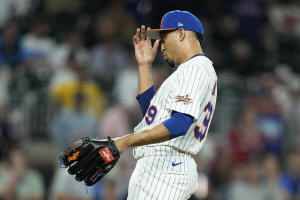Cal Raleigh successful as 4 of 5
challenges reverse calls in first All-Star use of robot umpire
[July 16, 2025]
By RONALD BLUM
ATLANTA (AP) — Cal Raleigh was just as successful with the first
robot umpire All-Star challenge as he was in the Home Run Derby.
Seattle's catcher signaled for an appeal to the Automated
Ball-Strike System in the first inning of the National League's win
Tuesday night, getting a strikeout for Detroit's Tarik Subal on San
Diego's Manny Machado.
“You take ‘em any way you can get ’em, boys,” Skubal said on the
mound.
Four of five challenges of plate umpire Dan Iassogna's calls were
successful in the first All-Star use of the ABS system, which could
make its regular-season debut next year.
Athletics rookie Jacob Wilson won as the first batter to call for a
challenge, reversing a 1-0 fastball from Washington's MacKenzie Gore
in the fifth inning that had been called a strike.
Miami’s Kyle Stowers lost when ABS upheld a full-count Andrés Muñoz
fastball at the bottom of the zone for an inning-ending strikeout in
the eighth.
Mets closer Edwin Díaz earned a three-pitch strikeout against Randy
Arozarena to end the top of the ninth on a pitch Iassogna thought
was outside.
Blue Jays catcher Alejandro Kirk used ABS to get a first-pitch
strike on a 100.1 mph Aroldis Chapman offering to Brendan Donovan
with two outs in the bottom half.
“The fans enjoy it. I thought the players had fun with it,” NL
manager Dave Roberts of the Los Angeles Dodgers said. “There’s a
strategy to it, if it does get to us during the season. But I like
it. I think it’s good for the game.”

Skubal had given up Ketel Marte's two-run double and retired the
Dodgers' Freddie Freeman on a groundout for his first out when he
got ahead of Machado 0-2 in the count. Skubal threw a 89.5 mph
changeup, and Iassogna yelled" “Ball down!”
Raleigh tapped his helmet just before Skubal tipped his cap,
triggering a review by the computer umpire that was tested in spring
training this year and could be adopted for regular-season use in
2026.
“Obviously, a strike like that it was, so I called for it and it
helped us out,” Raleigh said.
An animation of the computer analysis was shown on the Truist Park
scoreboard and the broadcast. Roberts laughed in the dugout after
the challenge.
“I knew it was a strike,” Machado said.
Skubal doesn't intend to use challenges during regular-season games
if the ABS is put in place. He says he'll rely on his catchers.
“I was joking around that I was going to burn two of them on the
first balls just so that way we didn’t have them the rest of the
game,” he said. “I’m just going to assume that it’s going to happen
next year.”
Before the game, baseball Commissioner Rob Manfred indicated the
sport's 11-man competition committee will consider the system for
next season.
"I think the ability to correct a bad call in a high-leverage
situation without interfering with the time of game because it’s so
fast is something we ought to continue to pursue,” Manfred said.
ABS decisions may have an error of margin up to a half-inch.
[to top of second column] |

New York Mets pitcher Edwin Díaz calls for challenge during ninth
inning at the MLB baseball All-Star game between the American League
and National League, Tuesday, July 15, 2025, in Atlanta. (AP Photo/Brynn
Anderson)

“Our guys do have a concern with that half inch,
what that might otherwise lead to particularly as it relates to the
number of challenges you may have, whether you keep those challenges
during the course of the game,” union head Tony Clark told the
Baseball Writers Association of America. “Does there need to be some
type of buffer zone consideration? Or do we want to find ourselves
in a world where it’s the most egregious misses that we want focus
in on?”
Manfred sounded less concerned.
“I don’t believe that technology supports the notion that you need a
buffer zone,” he said. “To get into the idea that there’s something
that is not a strike that you’re going to call a strike in a review
system, I don’t know why I would want to do that.”
MLB sets the top of the automated strike zone at 53.5% of a batter’s
height and the bottom at 27%, basing the decision on the midpoint of
the plate, 8 1/2 inches from the front and 8 1/2 inches from the
back. That contrasts with the rule book zone called by umpires,
which says the zone is a cube.
“We haven’t even started talking about the strike zone itself, how
that’s going to necessarily be measured, and whether or not there
are tweaks that need to be made there, too," Clark said. "So there’s
a lot of discussion that still needs to be had, despite the fact
that it seems more inevitable than not.”
Manfred has tested ABS in the minor leagues since 2019, using it for
all pitches and then switching to a challenge system. Each team gets
two challenges and a successful challenge is retained. Only
catchers, batters and pitchers can call for a challenge.
“Where we are on ABS has been fundamentally influenced by player
input,” he maintained. "If you had two years ago said to me: What do
the owners want to do? I think they would have called every pitch
with ABS as soon as possible. That’s because there is a fundamental,
very fundamental interest in getting it right, right? We owe it to
our fans to try to get it right because the players as I talked to
them over a couple of years really, expressed a very strong interest
or preference for the challenge system that we decided to test."
Skubal wondered is all contingencies had been planned for.
“If power goes out and we don’t have ABS — sometimes we don’t have
Hawk-Eye data or Trackman data. So what’s going to happen then?” he
said. “Are we going to expect umpires to call balls and strikes when
it’s an ABS zone?”
All contents © copyright 2025 Associated Press. All rights reserved
 |